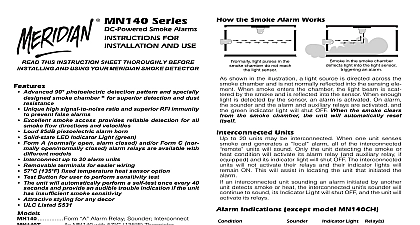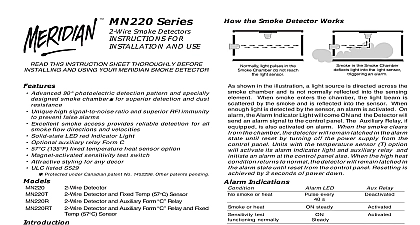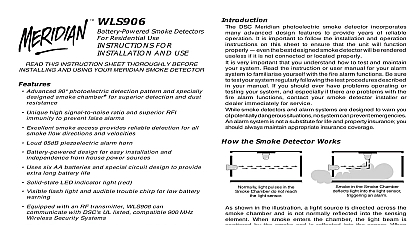DSC MN240 - Installation Manual - English - Meridian Four-Wire Photoelectric Smoke Detector

File Preview
Click below to download for free
Click below to download for free
File Data
| Name | dsc-mn240-installation-manual-english-meridian-four-wire-photoelectric-smoke-detector-2950341786.pdf |
|---|---|
| Type | |
| Size | 693.10 KB |
| Downloads |
Text Preview
INSTRUCTIONS FOR AND USE SERIES DC POWERED SMOKE DETECTORS THIS INSTRUCTION SHEET THOROUGHLY BEFORE AND USING YOUR MERIDIAN SMOKE DETECTOR Advanced 90 photoelectric detection pattern and specially smoke chamber for superior detection and dust Unique high signal to noise ratio and superior RFI immunity to false alarms Excellent smoke access provides reliable detection for all flow directions and velocities Optional Loud 85dB piezoelectric alarm horn Solid state LED red Indicator Light Form A normally opened alarm closed alarm relay standard Form C normally opened normally closed auxiliary 57 135 fixed temperature heat sensor option Magnet activated Sensitivity Test Switch The unit will automatically perform a self test once every 40 and provide an audible trouble indication in sounder units if the unit has insufficient smoke sensitivity Attractive styling for any decor ULC listed S529 Protected under Canadian Patent No 1452296 Other patents pending Alarm Relay Alarm Relay and Fixed Temp 57oC Sensor Alarm Relay and Auxiliary Form Relay Alarm Relay and Auxiliary Form Relay Fixed Temp 57oC Sensor Alarm Relay and Sounder Alarm Relay and Sounder and Fixed Temp Sensor Alarm Relay and Sounder and Auxiliary Relay Form Alarm Relay and Sounder and Auxiliary Relay and Fixed Temp 57oC Sensor DSC Meridian MN 240 Series Smoke Detectors are four wire detectors intended for open area protection They are suited commercial institutional and residential fire alarm systems DSC Meridian Photoelectric Smoke Detector incorporates many design features to provide years of reliable operation It important to follow the Installation and Operation instructions on sheet to ensure that the unit will function properly even the designed smoke detector will be rendered useless if it is not or located properly light pulses in the Smoke Chamber not reach the light sensor in the Smoke Chamber deflects light the light sensor triggering an alarm is very important that you understand how to test and maintain your Refer to the Instruction or User Manual for your alarm system familiarise yourself with how the Fire Alarm functions of your operate Be sure to test your system regularly following the procedures described in your manual If you should ever have operating or testing your system and especially if there are with the Fire Alarm functions contact your Smoke Detector or Dealer immediately for service smoke detectors and alarm systems are designed to warn you potentially dangerous situations no system can prevent An alarm system is not a substitute for life and property you should always maintain appropriate insurance the Smoke Detector Works shown in the illustration a light source is directed across the chamber and is not normally reflected into the sensing When smoke enters the chamber the light beam is by the smoke and is reflected into the sensor When light is detected by the sensor an alarm is activated On the Alarm Indicator Light will come ON and the Alarm Relay is to send an alarm signal to the control panel The Sounder the Auxiliary Relay if equipped are also activated on alarm the smoke clears from the smoke chamber the unit will reset the Sounder The Relay s and Indicator Light will in the alarm state until reset by turning off the power from the control panel Indications LED equipped Smoke or Heat every or Heat Self Test Normally Self Test Sensitivity Test Normally Test Sensitivity Smoke or Heat Latched in Alarm s steady every s 40 s Steady s every every every s of Smoke Detectors the Meridian Smoke Detector has been designed for reliability is important to know that all smoke detectors have limitations Smoke detectors will not work without power Devices powered a control panel will not function if the control panel AC and backup power supplies both fail Smoke detectors can only generate an alarm when smoke gets the Smoke Chamber anything that prevents smoke from the Smoke Chamber may prevent or delay an alarm to the Guidelines for Locating Smoke Detectors on this Sheet it is important that smoke detectors be located at least every floor of the premises preferably in every room It also important to avoid obstructions such as closed doors that prevent smoke from reaching the unit A smoke detector will detect a fire in the walls in the chimney or on the roof of a until smoke enters the Smoke Chamber Smoke detectors have certain obvious limitations they may not protection for someone smoking in bed for children playing matches or for sudden and violent explosions A smoke is a single part of overall fire safety precautions the smoke should never be seen as a substitute for a complete fire program for Locating Smoke Detectors smooth ceilings detectors may be spaced 9.1m 30 feet apart a guide Other spacings may be required depending on ceiling air movement the presence of joists uninsulated ceilings Consult NFPA 72 1993 CAN ULC S553 M86 or other appropriate standards for installation recommendations not locate smoke detectors at the top of peaked or gabled the dead air space in these locations may prevent the unit detecting smoke areas with turbulent air flow such as near doors fans or Rapid air movement around the detector may prevent from entering the unit not locate detectors in areas of high humidity not locate detectors in areas where the temperature rises above 100oF or falls below 5oC 41oF 1 2 Room Room detectors should always be installed in accordance with NFPA 72 the Fire Alarm Code Smoke detectors should always be located in with Paragraph 2.1.1.1 of NFPA 72 Chapter 2 Smoke detectors shall be installed outside of each separate area in the immediate vicinity of the bedrooms and on each additional of the family living unit including basements and excluding crawl spaces unfinished attics In new construction a smoke detector also shall be in each sleeping room 3 4 of detector here Measurements shown are to closest edge of the detector Your Smoke Detector use burning or materials test a smoke detector do not use high aerosols to smoke detectors use of burning or high aerosols can misleading and results the detector for sensitivity by activating the test feature To test the unit the test magnet against the case as shown below The Alarm Light will come ON the Alarm Relay will be activated the if equipped will sound and the alarm control panel indicate a fire alarm When the magnet is removed the will be silenced but the Alarm Light and Relay will remain Turn off the voltage supply to the detector for two seconds to the detector to normal the smoke detector does not function properly call your Smoke Installer or Dealer for service Sensitivity may be measured in a correlated UL217 or CAN S529 M87 smoke box DSC will conduct this test for a nominal If a returned unit is found outside of its marked sensitivity DSC will clean and restore the unit sensitivity to its marked sensitivity of installed detectors can be measured without with the Gemini Model 501 Aerosol Smoke Detector Follow the instructions supplied with the i


